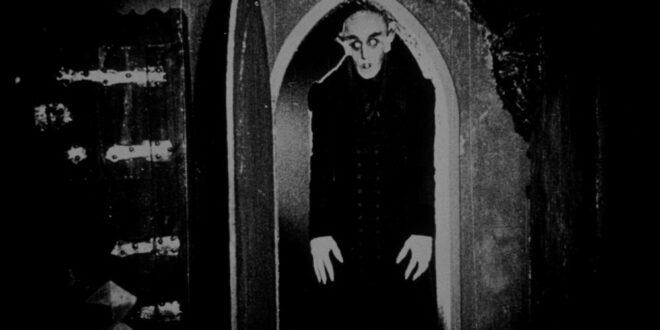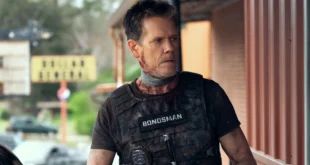Think of all the horror movies that have come out in the last one hundred years and you’ll immediately remember the classics. A Nightmare on Elm Street, Halloween, Insidious, Scream (that’s for you, Lacy Lou!), Alien, King Kong, The Fly, The Thing and on and on. But what about one of the very first vampire film? I’m talking about the one… the only… Nosferatu!
For those that haven’t heard of Nosferatu, here’s some backstory. In 1921, German director Friedrich Wilhelm Murnau and screenwriter Henrik Galeen wanted to make a loose adaptation based off the 1897 gothic horror novel, Dracula, written by Irish author Bram Stoker. The only problem was that Bram Stoker had passed away nine years earlier and his estate passed to his widow, Florence. Since there was no television or internet in 1921 and radio was in its infancy, Galeen and Murnau went ahead and filmed their movie anyway without Florence Stoker’s permission. All they did was change the setting from 1890 London to 1838 Germany and the names of the characters. Florence Stoker found out after the movie had come out on March 4, 1922, when she received a letter from someone who was at the movie’s Berlin premiere and asked if she was aware this had happened. Florence was furious and sued for copyright reasons. Not only did she want monetary compensation but she wanted all copies of the movie destroyed.
Florence actually won her lawsuit and 95% of all film cannisters of Nosferatu was indeed destroyed. Luckily for all of us, there were copies that remained, and after years underground, the film managed to make its way around the world in the late 1920s, even popping up in the United States. Florence Stoker herself passed away in 1937, leaving no actual copyright protection since Nosferatu was made without permission and had no legal rights in Germany. That’s a hell of a story for an 80 minute piece of entertainment.
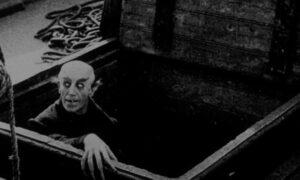
But what about the movie itself? Its actually pretty good if you know what you’re in for. Many people in 2022 are used to 4K and high definition television, but we’re going all the way back to 1922 for Nosferatu to before sound in movies was invented. Silent films relied on method acting, subtitles, and score to sell the story. A lot of actors and actresses overacted since there was no actual dialogue. If you’ve ever seen silent films or movies released around that time, you’ll notice a lot of makeup on the actors. Because technology was limited, they had to wear white makeup and black eye-liner just so the cameras could pick up their faces.
Now, let’s get to the plot. This movie’s Jonathan Harker, named Thomas Hutter (Gustav Von Wangenheim), is sent by eccentric real estate agent Knock—this movie’s Renfield—(Alexander Granach) to Transylvania to sell the house across the street from Thomas in his fictional town of Wisborg. In town, Hutter asks around about Count Orlok/Dracula (Max Schreck) and the townspeople freak out at the mere mention of him. Once he gets to Orlok’s castle, he meets the Count who looks as creepy as any character in movie history. Orlok happily signs the papers to become the new homeowner in Wisborg but takes a liking to a picture of Hutter’s wife, Ellen/Mina (Greta Schröder), and says she has a great looking neck. Har de har har!
Hutter then realizes that Orlok only comes out at night and then figures out he’s a vampire. The Count loads up a bunch of coffins onto a stagecoach to be delivered to a steam ship that will take him from Transylvania to Germany (don’t ask). Meanwhile, Hutter rides on horseback from Transylvania to Germany (again, don’t ask) to warn the townspeople that Count Orlok is a vampire! Its a race against time. Will Hutter make it first or Orlok? Watch Nosferatu to find out.
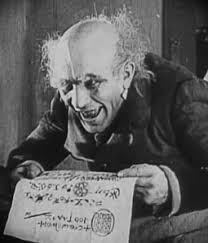
The bread and butter—besides the brilliant, creepy score by Hans Erdmann—is the acting and makeup. Because there’s no dialogue, it’s all about how the characters are presented through overacting. Max Schreck was cast as Count Orlok, and he did a tremendous job playing one of the creepiest characters in movie history. His iconic look scared the daylights out of people in 1922 and still does today. His long finger claws and signature front teeth fangs go with his bald head and pointy ears perfectly. He walks hunched up which must have been very painful to pull off, but it was all worth it.
Another creepy performance was from Alexander Granach as Knock. In the book, Renfield is the insane servant of Count Dracula, and Granach pulls off the look and insanity very well. It’s a testament to the effects crew that worked on this film to make characters look scary enough to scare people a hundred years later.
Count Orlok is the grandfather of silent killers such as Jason Voorhees and Michael Myers. They don’t talk at all; they just kill. Orlok does have on screen subtitles for his dialogue but you don’t HEAR his voice, leaving it up to your imagination to come up with how he sounds. All in all, he one of the most memorable characters to this day because of the look, the acting and the delivery.
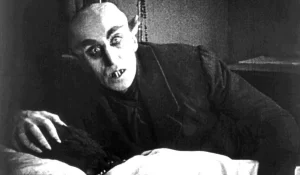
Now for the million dollar question… does it hold up one hundred years later? Yes, if you like silent films. One of the only flaws is the pacing, but that’s common with silent films. Sometimes, there are unusually long shots of an actor doing something that was designed to prolong the movie since there was no dialogue to carry it. If you’re used to silent films, you can overlook it, but it can be a pain for someone used to 4K. Also, some of the plot has been changed for failed legal purposes and it can get kind of silly, especially the scenes on the ship, which I won’t spoil. Still, this film is considered the original horror movie. Everything you’ve seen the last one hundred years is because of Count Orlok and Nosferatu.
One last thing… since the movie had no legal rights to begin with, you’re free to do whatever you want with it since it’s now in the Public Domain. If you want to use scenes for a school project or upload the entire movie on your YouTube channel, you can! Hell, you can upload the movie with your own music if you want… as long as the music isn’t copyright protected. Imagine listening to 80 minutes of KISS or Michael Jackson while Nosferatu plays. All in all, it’s worth a look if you’re a vampire fan because it was one of the first.
 PopHorror Let's Get Scared
PopHorror Let's Get Scared
